
28978 Ixion (, provisional designation 2001 KX76) is a large trans-Neptunian object and a possible dwarf planet. It is located in the Kuiper belt, a region of icy objects orbiting beyond Neptune in the outer Solar System. Ixion is classified as a plutino, a dynamical class of objects in a 2:3 orbital resonance with Neptune. It was discovered in May 2001 by astronomers of the Deep Ecliptic Survey at the Cerro Tololo Inter-American Observatory, and was announced in July 2001. The object is named after the Greek mythological figure Ixion, who was a king of the Lapiths.
8405 Asbolus is a centaur orbiting in the outer Solar System between the orbits of Jupiter and Neptune. It was discovered on 5 April 1995, by James Scotti and Robert Jedicke of Spacewatch (credited) at Kitt Peak Observatory in Arizona, United States. It is named after Asbolus, a centaur in Greek mythology and measures approximately 80 kilometers in diameter.
(15874) 1996 TL66 (provisional designation 1996 TL66) is a trans-Neptunian object of the scattered disc orbiting in the outermost region of the Solar System.

19521 Chaos is a cubewano, a Kuiper-belt object not in resonance with any planet. Chaos was discovered in 1998 by the Deep Ecliptic Survey with Kitt Peak's 4 m telescope. Its albedo is 0.050+0.030
−0.016, making it, with its absolute magnitude (H) of 4.8, equivalent to a single spherical body 600+140
−130 km in diameter.

(55565) 2002 AW197 (provisional designation 2002 AW197) is a classical, non-resonant trans-Neptunian object from the Kuiper belt in the outermost region of the Solar System, also known as a cubewano. With a likely diameter of at least 700 kilometers (430 miles), it is approximately tied with 2002 MS4 and 2013 FY27 (to within measurement uncertainties) as the largest unnamed object in the Solar System. It was discovered at Palomar Observatory in 2002.
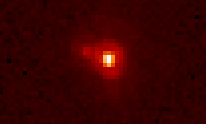
(55637) 2002 UX25 (provisional designation 2002 UX25) is a trans-Neptunian object that orbits the Sun in the Kuiper belt beyond Neptune. It briefly garnered scientific attention when it was found to have an unexpectedly low density of about 0.82 g/cm3.

(84522) 2002 TC302 (provisional designation 2002 TC302) is a mid-sized trans-Neptunian object located in the outermost region of the Solar System. It was discovered on 9 October 2002, by American astronomers Mike Brown, Chad Trujillo and David Rabinowitz at the Palomar Observatory in California. The resonant trans-Neptunian object stays in a 2:5 resonance with Neptune. It has a reddish color, a rotation period of 56.1 hours and measures at least 500 kilometers (310 miles) in diameter.
(119070) 2001 KP77 (provisional designation 2001 KP77) is a resonant trans-Neptunian object in the Kuiper belt, a circumstellar disc located in the outermost region of the Solar System. It was discovered on 23 May 2001, by American astronomer Marc Buie at the Cerro Tololo Observatory in Chile. The object is locked in a 4:7 orbital resonance with Neptune. It has a red surface color and measures approximately 176 kilometers (110 miles) in diameter. As of 2021, it has not been named.

(208996) 2003 AZ84 (provisional designation 2003 AZ84) is a trans-Neptunian object with a possible moon located in the outer regions of the Solar System. It is approximately 940 kilometers across its longest axis, as it has an elongated shape. It belongs to the plutinos – a group of minor planets named after its largest member Pluto – as it orbits in a 2:3 resonance with Neptune in the Kuiper belt. It is the third-largest known plutino, after Pluto and Orcus. It was discovered on 13 January 2003, by American astronomers Chad Trujillo and Michael Brown during the NEAT survey using the Samuel Oschin telescope at Palomar Observatory.
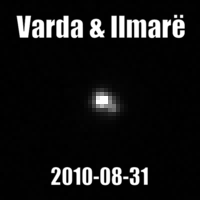
174567 Varda (provisional designation 2003 MW12) is a binary trans-Neptunian planetoid of the resonant hot classical population of the Kuiper belt, located in the outermost region of the Solar System. Its moon, Ilmarë, was discovered in 2009.
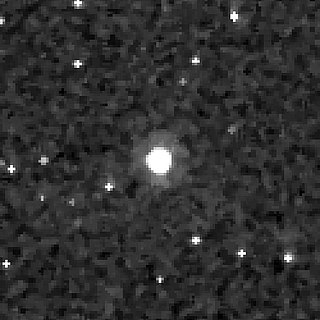
(119951) 2002 KX14 (provisional designation 2002 KX14) is a medium-sized trans-Neptunian object (TNO) residing within the Kuiper belt. It was discovered on 17 May 2002 by Michael E. Brown and Chad Trujillo.

15810 Arawn ((provisional designation 1994 JR1) is a trans-Neptunian object (TNO) from the inner regions of the Kuiper belt, approximately 133 kilometres (83 mi) in diameter. It belongs to the plutinos, the most populous class of resonant TNOs. It was named after Arawn, the ruler of the underworld in Welsh mythology, and was discovered on 12 May 1994, by astronomers Michael Irwin and Anna Żytkow with the 2.5-metre Isaac Newton Telescope at Roque de los Muchachos Observatory in the Canary Islands, Spain.
(35671) 1998 SN165 (provisional designation 1998 SN165) is a trans-Neptunian object from the Kuiper belt located in the outermost region of the Solar System. It was discovered on 23 September 1998, by American astronomer Arianna Gleason at the Kitt Peak National Observatory near Tucson, Arizona. The cold classical Kuiper belt object is a dwarf planet candidate, as it measures approximately 400 kilometers (250 miles) in diameter. It has a grey-blue color (BB) and a rotation period of 8.8 hours. As of 2021, it has not been named.
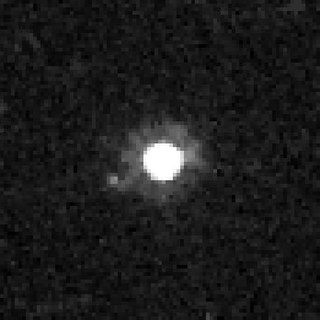
Quaoar is a ringed dwarf planet in the Kuiper belt, a region of icy planetesimals beyond Neptune. A non-resonant object (cubewano), it measures approximately 1,086 km (675 mi) in diameter, about the size of Saturn's moon Dione or half the size of Pluto. The object was discovered by American astronomers Chad Trujillo and Michael Brown at the Palomar Observatory on 4 June 2002. Signs of water ice on the surface of Quaoar have been found, which suggests that cryovolcanism may be occurring on Quaoar. A small amount of methane is present on its surface, which can only be retained by the largest Kuiper belt objects.
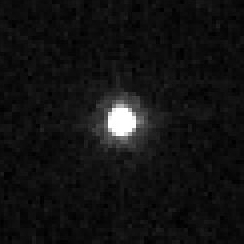
471143 Dziewanna (provisional designation 2010 EK139) is a trans-Neptunian object in the scattered disc, orbiting the Sun in the outermost region of the Solar System.
(268361) 2007 JJ43 is a large trans-Neptunian object (TNO) orbiting the Sun near the outer edge of the Kuiper belt. Its discovery images were taken in 2007, and its absolute magnitude of 4.5 is one of the twenty brightest exhibited by TNOs. Assuming it has a typical albedo, this would make it roughly the same size as Ixion (about 530–620 km diameter). In a paper in the Astrophysical Journal Letters András Pál and colleagues estimate a diameter for (278361) 2007 JJ43 of 610+170
−140 km.

(612533) 2002 XV93 (provisional designation 2002 XV93) is a trans-Neptunian object (TNO) with an absolute magnitude of 5.4. A 2:3 orbital resonance with Neptune makes it a plutino.

(524366) 2001 XR254, provisional designation 2001 XR254, is a trans-Neptunian object and binary system from the classical Kuiper belt, located in the outermost region of the Solar System. The cubewano belongs to the cold population and measures approximately 171 kilometers (110 miles). It was first observed on 10 December 2001, by astronomers at the Mauna Kea Observatory, Hawaii. Its 140-kilometer sized companion was discovered by the Hubble Space Telescope in June 2006.
(523764) 2014 WC510 (provisional designation 2014 WC510) is a binary trans-Neptunian object discovered on 8 September 2011 by the Pan-STARRS survey at the Haleakalā Observatory in Hawaii. It was found by Pan-STARRS on 20 November 2014 and was announced later in July 2016 after additional observations and precovery identifications. It is in the Kuiper belt, a region of icy objects orbiting beyond Neptune in the outer Solar System. It is classified as a plutino, a dynamical class of objects in a 2:3 orbital resonance with Neptune. On 1 December 2018, a team of astronomers observed a stellar occultation by the object, which revealed that it is a compact binary system consisting of two separate components in close orbit around each other. The primary and secondary components are estimated to have diameters of around 180 km (110 mi) and 140 km (87 mi), respectively.
2011 JY31 is a binary trans-Neptunian object from the Kuiper belt, located in the outermost region of the Solar System. It is a cold classical Kuiper belt object. 2011 JY31 was discovered on 4 May 2011, by a team of astronomers using one of the Magellan Telescopes in Chile during the New Horizons KBO Search for a potential flyby target for the New Horizons spacecraft. Distant observations by New Horizons from September 2018 revealed its binary nature, showing two 68 km (42 mi)-wide components in a tight, mutual orbit 200 km (120 mi) apart.







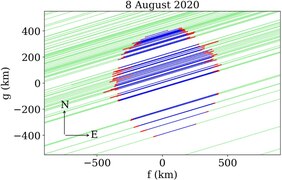
![Artistic comparison of Pluto, Eris, Haumea, Makemake, Gonggong, Quaoar, Sedna, Orcus, Salacia, 2002 MS4, and Earth along with the Moon
.mw-parser-output .hlist dl,.mw-parser-output .hlist ol,.mw-parser-output .hlist ul{margin:0;padding:0}.mw-parser-output .hlist dd,.mw-parser-output .hlist dt,.mw-parser-output .hlist li{margin:0;display:inline}.mw-parser-output .hlist.inline,.mw-parser-output .hlist.inline dl,.mw-parser-output .hlist.inline ol,.mw-parser-output .hlist.inline ul,.mw-parser-output .hlist dl dl,.mw-parser-output .hlist dl ol,.mw-parser-output .hlist dl ul,.mw-parser-output .hlist ol dl,.mw-parser-output .hlist ol ol,.mw-parser-output .hlist ol ul,.mw-parser-output .hlist ul dl,.mw-parser-output .hlist ul ol,.mw-parser-output .hlist ul ul{display:inline}.mw-parser-output .hlist .mw-empty-li{display:none}.mw-parser-output .hlist dt::after{content:": "}.mw-parser-output .hlist dd::after,.mw-parser-output .hlist li::after{content:" * ";font-weight:bold}.mw-parser-output .hlist dd:last-child::after,.mw-parser-output .hlist dt:last-child::after,.mw-parser-output .hlist li:last-child::after{content:none}.mw-parser-output .hlist dd dd:first-child::before,.mw-parser-output .hlist dd dt:first-child::before,.mw-parser-output .hlist dd li:first-child::before,.mw-parser-output .hlist dt dd:first-child::before,.mw-parser-output .hlist dt dt:first-child::before,.mw-parser-output .hlist dt li:first-child::before,.mw-parser-output .hlist li dd:first-child::before,.mw-parser-output .hlist li dt:first-child::before,.mw-parser-output .hlist li li:first-child::before{content:" (";font-weight:normal}.mw-parser-output .hlist dd dd:last-child::after,.mw-parser-output .hlist dd dt:last-child::after,.mw-parser-output .hlist dd li:last-child::after,.mw-parser-output .hlist dt dd:last-child::after,.mw-parser-output .hlist dt dt:last-child::after,.mw-parser-output .hlist dt li:last-child::after,.mw-parser-output .hlist li dd:last-child::after,.mw-parser-output .hlist li dt:last-child::after,.mw-parser-output .hlist li li:last-child::after{content:")";font-weight:normal}.mw-parser-output .hlist ol{counter-reset:listitem}.mw-parser-output .hlist ol>li{counter-increment:listitem}.mw-parser-output .hlist ol>li::before{content:" "counter(listitem)"\a0 "}.mw-parser-output .hlist dd ol>li:first-child::before,.mw-parser-output .hlist dt ol>li:first-child::before,.mw-parser-output .hlist li ol>li:first-child::before{content:" ("counter(listitem)"\a0 "}
.mw-parser-output .navbar{display:inline;font-size:88%;font-weight:normal}.mw-parser-output .navbar-collapse{float:left;text-align:left}.mw-parser-output .navbar-boxtext{word-spacing:0}.mw-parser-output .navbar ul{display:inline-block;white-space:nowrap;line-height:inherit}.mw-parser-output .navbar-brackets::before{margin-right:-0.125em;content:"[ "}.mw-parser-output .navbar-brackets::after{margin-left:-0.125em;content:" ]"}.mw-parser-output .navbar li{word-spacing:-0.125em}.mw-parser-output .navbar a>span,.mw-parser-output .navbar a>abbr{text-decoration:inherit}.mw-parser-output .navbar-mini abbr{font-variant:small-caps;border-bottom:none;text-decoration:none;cursor:inherit}.mw-parser-output .navbar-ct-full{font-size:114%;margin:0 7em}.mw-parser-output .navbar-ct-mini{font-size:114%;margin:0 4em}
v
t
e EightTNOs.png](http://upload.wikimedia.org/wikipedia/commons/thumb/9/91/EightTNOs.png/310px-EightTNOs.png)



















